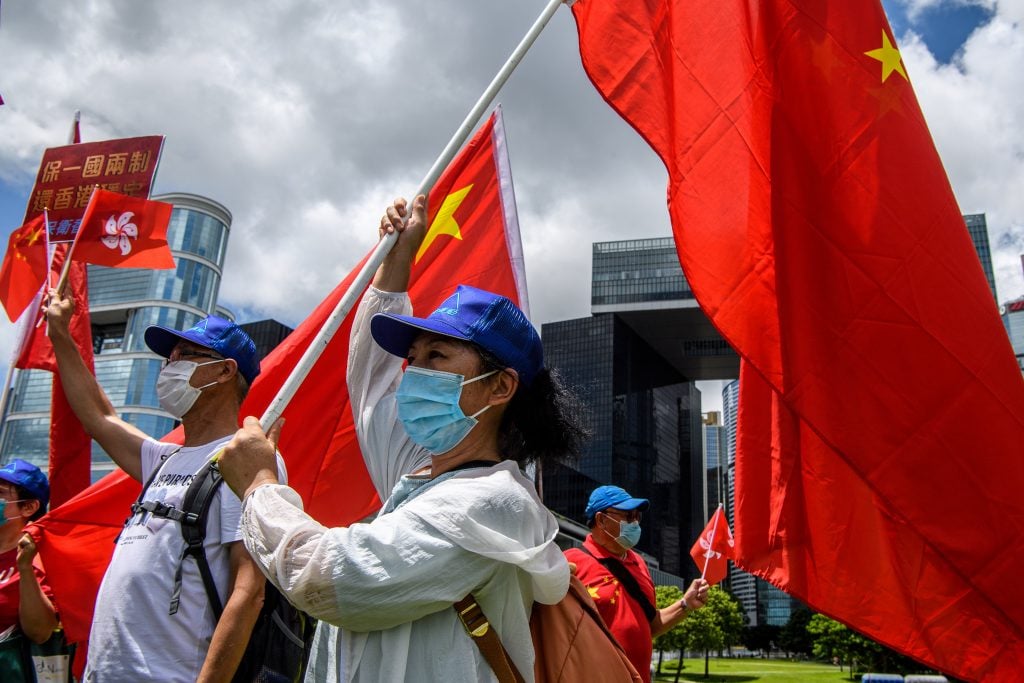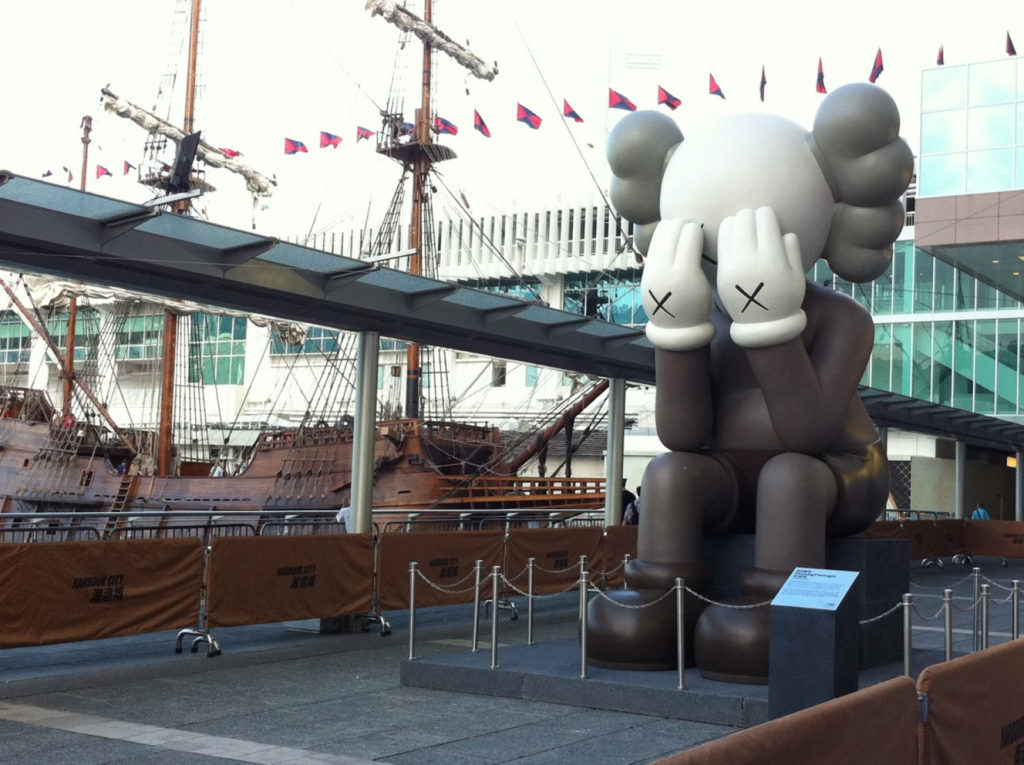Every Monday morning, Artnet News brings you The Gray Market. The column decodes important stories from the previous week—and offers unparalleled insight into the inner workings of the art industry in the process.
This week, pulling the industry’s focus toward a siege devoid of shirtless morons in Viking headgear…
DARKEST BEFORE THE DAWN
Before daybreak last Tuesday, Hong Kong police arrested 53 activists and politicians under the national security law implemented by the Chinese Communist Party last summer. The crackdown marked a worrying new inflection point in the trajectory of the “one country, two systems” policy that was supposed to keep the city’s population and economy freer than their mainland counterparts until 2047. It also seems to accelerate a reckoning between an increasingly strident Beijing and all Western institutions hoping to continue operating in Hong Kong—including art businesses.
As a refresher, top lawmakers in the central Chinese government unanimously ratified the Hong Kong national security law on June 30, 2020. Amnesty International called its provisions “dangerously vague and broad,” allowing “virtually anything” displeasing to Beijing to be classified as criminal. Furthermore, the law “asserts jurisdiction over people who are not residents of Hong Kong and have never even set foot there,” meaning accused individuals risk arrest and/or prosecution anytime they enter Chinese territory, no matter how briefly.
The consequences began piling up immediately. Authorities detained and arrested multiple pro-democracy protesters the day after the law’s passage. In the ensuing months, officials fired or intimidated university professors whose curricula included the specter of Hong Kong independence. Higher-ups delayed an election for the city’s local legislative council last July (ostensibly as a public health precaution), then purged four pro-democracy incumbents on ideological grounds in November. Soon after, the remaining opposition lawmakers resigned in solidarity with their ousted colleagues, leaving the resulting council unified in its loyalty to Beijing.
What separates this January’s enforcement actions from these earlier ones are the identities of the people swept into the dragnet. According to the New York Times, Wednesday’s raid “rounded up not only some of the most aggressive critics of the Hong Kong government but also little-known figures who had campaigned on far less political issues” in the legislative primaries last summer.
They included Jeffrey Andrews, who the Times described as a local social worker “known more for… helping members of ethnic minority groups than for fiery [political] slogans.” Also among the arrestees was Lee Chi-yung, whose platform “was devoted to… promoting accessibility in Hong Kong, in memory of his late daughter, who had used a wheelchair all her life.”
Notably, both candidates finished in last place in their respective races. This detail underscores that authorities are expanding their definition of national security threats to encompass moderates with little actual influence over Hong Kongers.
These events signal that the city’s chances of remaining a legitimately semi-autonomous region until 2047, let alone becoming a permanent liberal democracy, have eroded with frightening speed. That should be troubling enough to artists and art businesses based there.
Yet even for those who might be willing to continue within an ethical gray zone, the Chinese Communist Party’s rapidly tightening grip on Hong Kong suggests that the latter’s days as a viable hub for foreign entrepreneurship are numbered in the low digits, too.

Jeff Koons poses with his piece Gazing Ball (Bottlerack) (2016). Photo by Anthony Wallace/AFP/Getty Images.
SHINY OBJECTS
When discussing the national security law’s most worrying implications for Hong Kong’s art world, many Westerners tend to focus on the high likelihood of censorship. After all, now that authorities can label “virtually anything” sedition, creative expression is bound to suffer (despite some artists’ courageous efforts to camouflage political themes). That’s a clear loss for culture, to say nothing of the human cost for people who could be jailed, silenced, or driven into exile for following their artistic instincts.
However, I think this fixation may be somewhat misguided, especially when it comes to major Western dealers who have expanded to the city. I spent some time over the weekend scrolling through past exhibitions held by blue-chip galleries in their Hong Kong branches, and there is little evidence the artists who showed there were being featured for their searing insights on regional socio-politics—even in the years before the national security law’s implementation. No disrespect, but I’m pretty confident Xi Jinping has lost zero sleep over fears that revolutionary fervor would take hold in Hong Kongers thanks to the visual stylings of Alex Israel or Marcel Dzama.
My look back through the archives was a great reminder that wealth is its own floating world—a cross-cultural community that supersedes national borders. Whether focused on artwork or cars or timepieces, the wish list of the average high-net-worth individual in Hong Kong probably has a lot of crossover with those of their counterparts in New York, London, and Paris. Tech and business analyst Scott Galloway summarized it this way in a 2015 lecture:
“Rich people are the most boring people in the world. They smell, look, and feel alike. They all fly British Airways, wear Hermès, and party in St. Barths… Luxury brands are able to go global faster because rich people aspire to the same things.”
In other words, my sense is that the content of most works sold in Hong Kong this generation has largely mirrored the content of most works sold in art-market capitals featuring long traditions of free (or at least much freer) national elections and free international markets. The reason isn’t political pressure; it’s the consensus of taste around art-as-luxury-object.
And if that’s the case, then contrary to the dominant perception among Westerners, censorship likely won’t be what clips the international art trade’s wings in Hong Kong. Instead, Western dealers there should fear the blade of economic nationalism, which officials could swing as swiftly and suddenly as police raided the homes of political moderates last week.

Pro-China supporters display Chinese and Hong Kong flags during a rally near the government headquarters in Hong Kong on June 30, 2020, as China passed a sweeping national security law for the city. (Photo by ANTHONY WALLACE/AFP via Getty Images)
GROWING, GROWING, GONE
The day of the latest arrests, Finn Lau, the dissident founder of pro-democracy group Hong Kong Liberty, penned a Financial Times op-ed urging Western nations to take meaningful action against China’s increasingly authoritarian behavior. In the piece, he offered crucial context that reinforced my trepidations about the city’s future as a hub of the global economy.
Lau reminded readers that international markets refused to engage with the People’s Republic of China for decades after its founding in 1949. When the UK initiated what was to be the 50-year handover of Hong Kong in 1997, Beijing allowed the semi-autonomous district to maintain many of the freedoms it enjoyed under British rule so that it could attract foreign investment and trade still incompatible with attitudes toward the mainland’s politics.
However, despite the central government’s increasingly distressing record on human rights inside and outside Hong Kong, international markets have spent much of the last 20 years softening their resistance to the Chinese Communist Party. In Lau’s words, the US “began trading with China with few restrictions” in 1999, and “the rest of the world followed in 2001 when China joined the World Trade Organization.” Since then, one of the defining stories of the 21st century has been the growth of the People’s Republic into the second largest economy on earth.
This power-up has equipped Communist Party officials with a historic amount of leverage in international relations. This reality was fortified again just before the new year, when the European Union finalized a major investment deal with Beijing. In exchange, Brussels was more than happy to accept what activist and former Hong Kong lawmaker Nathan Law called an “empty promise on [ending] forced labor” carried out by China’s Uyghur Muslim population.
As a result, Finn Lau explained, “President Xi Jinping’s party does not believe it needs Hong Kong, because mainland China has become capitalistic, albeit in a state-run form.” So if officials in Beijing believe the economic benefits of a more liberal Hong Kong no longer outweigh the costs to national unity, why should they maintain the “one country, two systems” framework any longer?
It might seem contradictory at first to argue that increased Western trade and investment with China could lead to problems for Western art businesses. But it’s not as if two decades of supposed progress on this front have empowered a slew of international dealers and auction houses to meaningfully transact anywhere under the central government’s influence except Hong Kong.
Pace, one of the few international sellers that had managed to secure a foothold in Beijing, abandoned that location in 2019, with founder Arne Glimcher stating it was “impossible to do business in mainland China right now, and it has been for a while.” Other prominent dealers and auction houses only operate offices in Shanghai rather than full-fledged sales operations; a handful rely on partnerships with Chinese-owned companies to sustain their presence.
More importantly, the escalating series of fast-twitch strikes enabled by the national security law prove that Xi and his subordinates are ready, willing, and able to upend decades of precedent in Hong Kong without warning. If they decide the city’s status as an exceptional node in global finance and trade networks no longer serves their needs, authorities could abruptly impose many of the same protectionist regulations and exorbitant taxes (including on artworks) that have so thoroughly undermined Western businesses’ attempts to integrate with the mainland.
In that case, the art market would be far too small a force to turn back the tide sweeping Hong Kong closer and closer to a point of no return. The damage to the industry would be incalculable. But it would pale in comparison to the greater harm already being caused by the clampdown.
[The New York Times]
That’s all for this week. ‘Til next time, remember: things change very slowly, then all at once.








